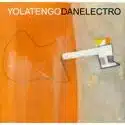
What’s most interesting about Yo La Tengo’s new EP release Danelectro is how thoroughly it is about fleshing out musical ideas. The three Yo La Tengo tracks, “Danelectro 3”, “Danelectro 2” and “Danelectro 1”, are moody instrumentals that capture the group’s gift for creating quiet, intense soundscapes. Yet in listening in listening to them it is not really surprising that they were not included on their latest full-length release And Then Nothing Turned Itself Inside Out. They are each like sketches on the way to making a painting. The ideas are all there, but they have not been totally worked through. The twist here though is that the responsibility for bringing the ideas to fruition is handed over to Q-Unique (from Matador label mates Arsonists), Kit Clayton (a San Francisco-based electronic musician) and Nobukazu Takemura (who last appeared on my radar screen when he participated in the big nod to composer Steve Reich, Reich Remixed).
Q-Unique’s too brief beats and scratches re-mix of “Danelectro 1” seems content to lean on the nice guitar and bass loop of the original and add some Spooky-esque atmospherics, which is nice enough, but it doesn’t really push this material in any especially bold direction. (To be fair though, “Danelectro 1” is certainly the slightest of all the originals, both musically and in terms of the amount of raw material available for Q-Unique to work with given that the piece clocks in at only a little more than one minute.) In comparison, Kit Clayton’s take on “Danelectro 3” is far more intrusive, and ultimately more satisfying. Clayton’s strategy is to compress the airiness from the original, speeding up and agitating the piece to the point that the listener focuses only on what rises to the top: swirling guitar and the rhythm of drones pushed to the limit.
Undoubtedly the most ambitious of these remixes is Nobukazu Takemura’s work with “Danelectro 2”. He starts by emphasizing Yo La Tengo’s high end while not messing with the tempo, giving us a bright complex sound set off by a great pitter patter of percussion. Then the ante is upped considerably when Takemura plays with his raw material as keyboard loops, layering them into dense, intricate patterns. With this remix Takemura has taken Yo La Tengo’s original and elevated it into something that neither he nor Yo La Tengo could alone have made, which is really all you can ask for.
